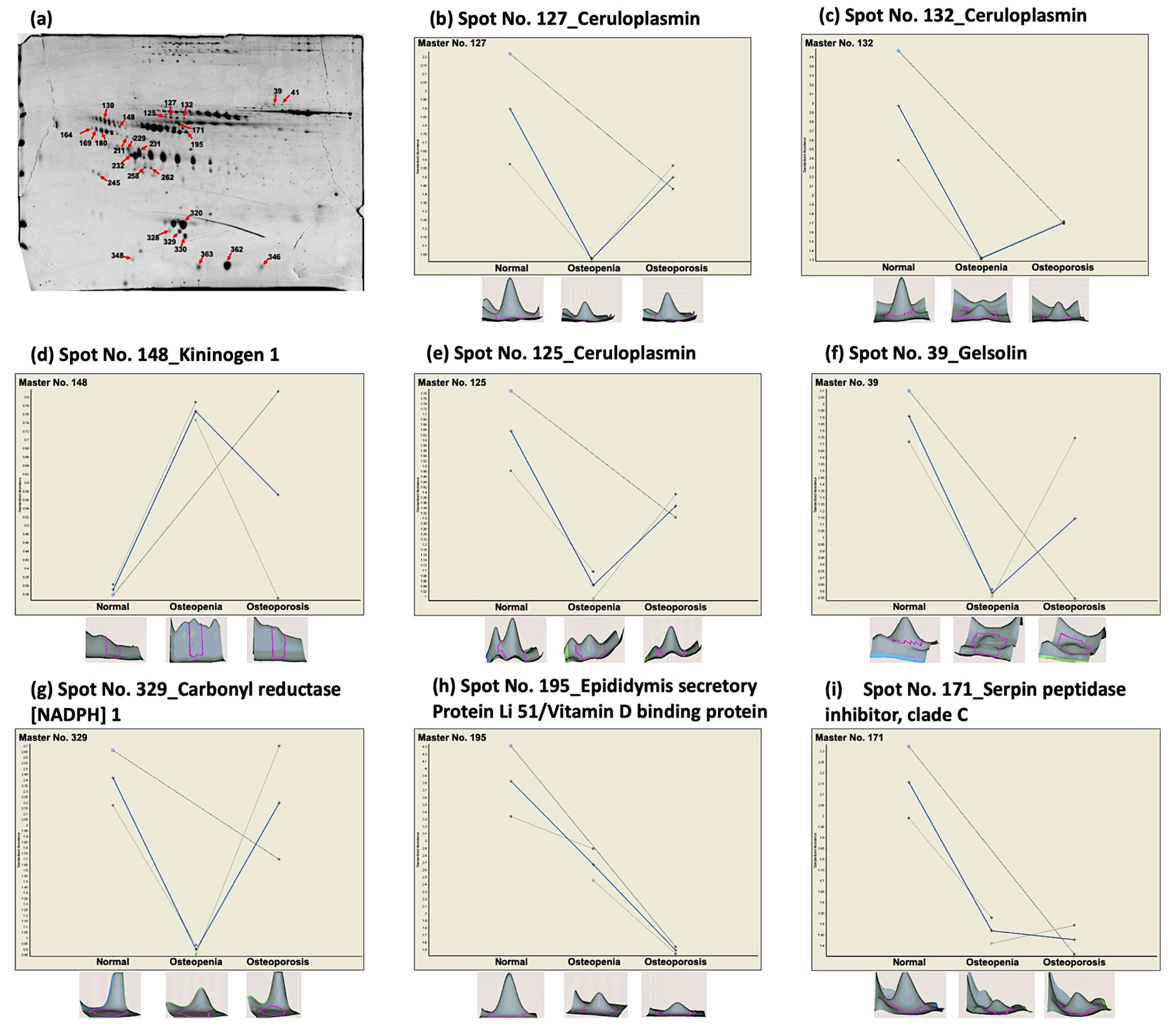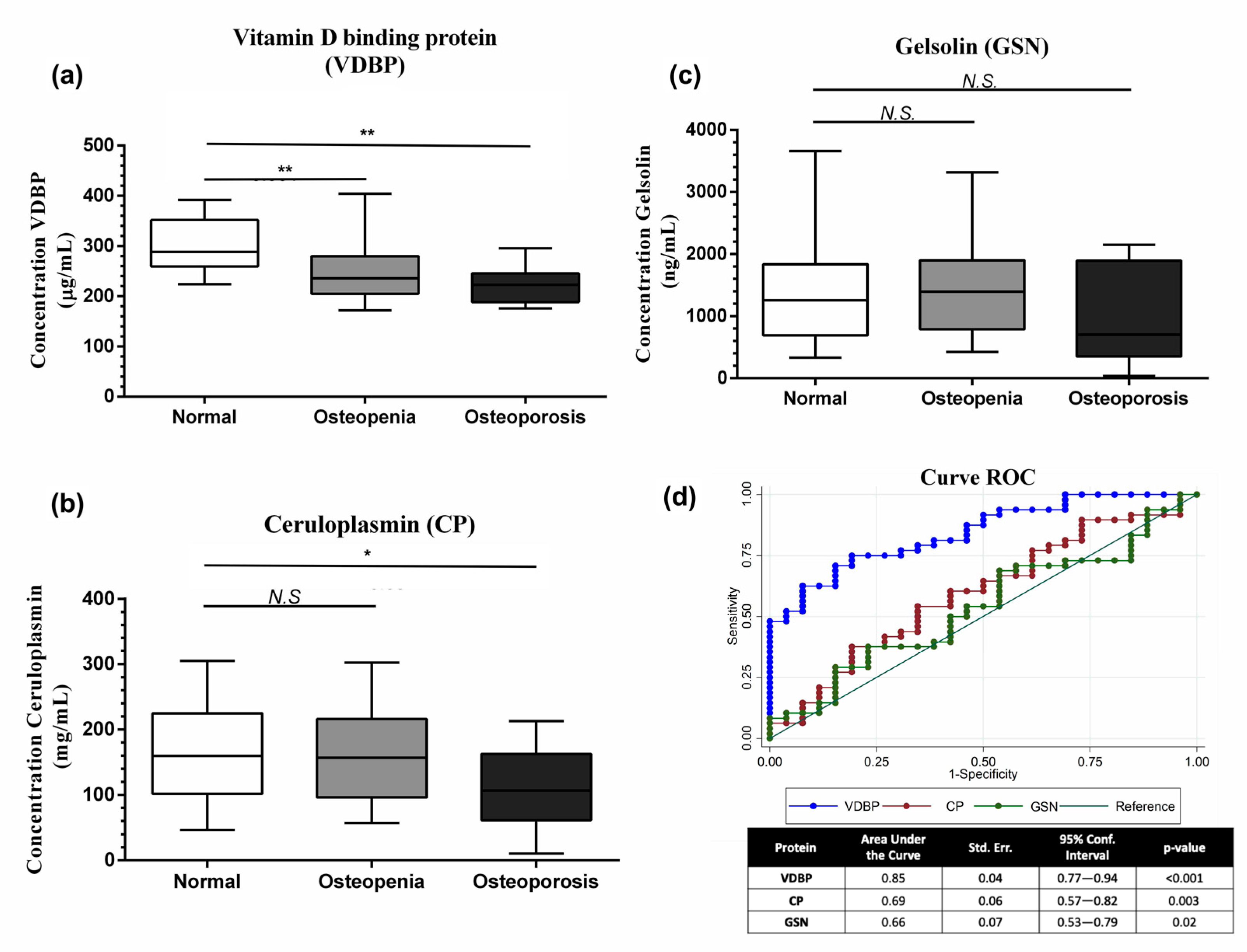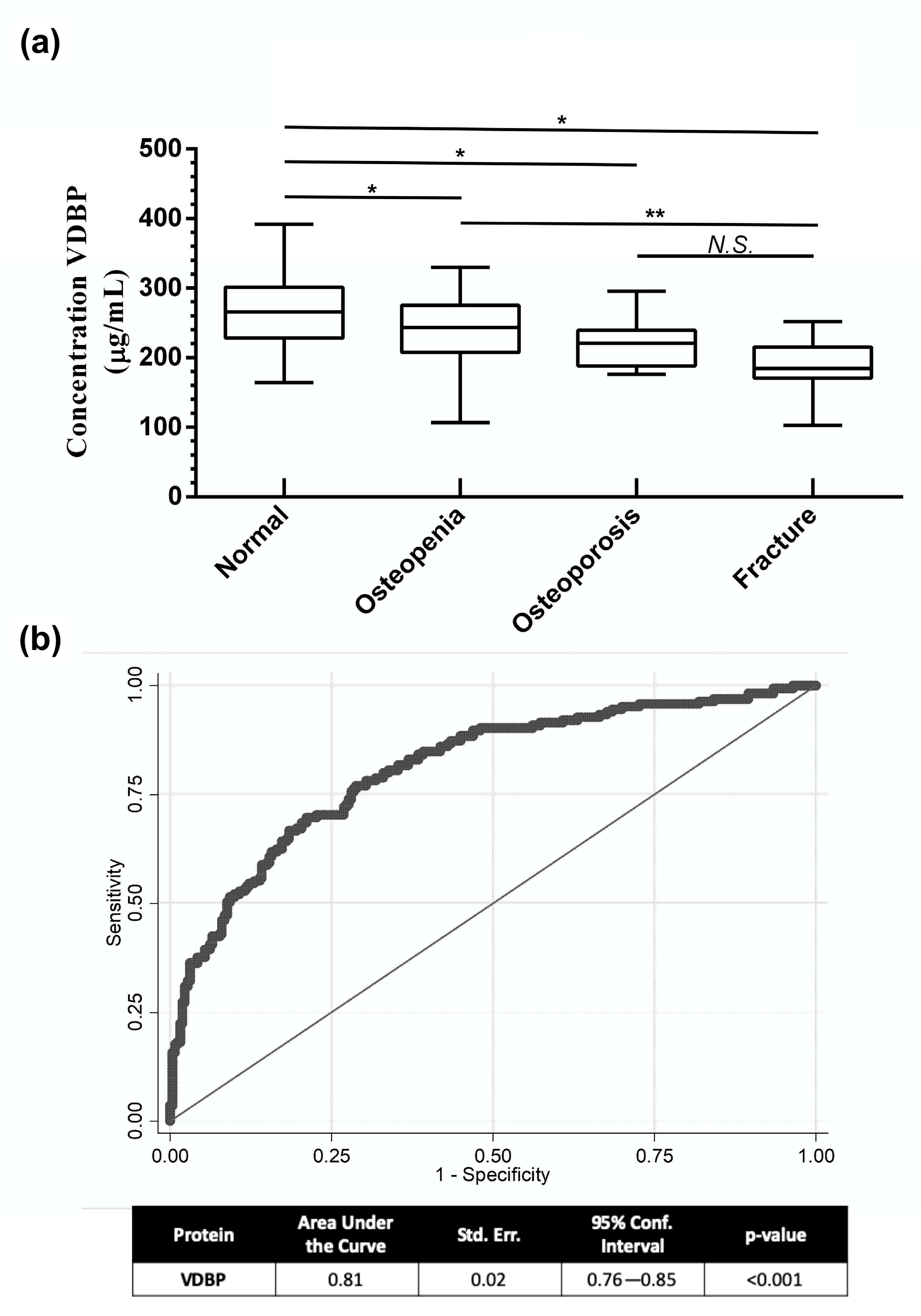Serum Proteomic Analysis Reveals Vitamin D-Binding Protein (VDBP) as a Potential Biomarker for Low Bone Mineral Density in Mexican Postmenopausal Women
Abstract
1. Introduction
2. Materials and Methods
2.1. Study Participants
2.2. Bone Mineral Density (BMD) Measurement and Osteoporosis Diagnosis
2.3. Serum Sample Preparation
2.4. 2D DIGE and Image Analysis
2.5. Protein Identification by MALDI TOF/TOF Mass Spectrometry
2.6. ELISA Analysis
2.7. Statistical Analysis
3. Results
3.1. 2D-DIGE Differential Protein Expression Analysis
3.2. MALDI-TOF/TOF Protein Identification Analysis
3.3. Gelsolin (GSN), Vitamin D-Binding Protein (VDBP), Ceruloplasmin (CP), and ELISA Validation
3.4. Serum VDBP Levels as a Potential Biomarker
4. Discussion
5. Conclusions
Supplementary Materials
Author Contributions
Funding
Acknowledgments
Conflicts of Interest
References
- Ensrud, K.E.; Crandall, C.J. Osteoporosis. Ann. Intern. Med. 2017, 167, ITC17–ITC31. [Google Scholar] [CrossRef] [PubMed]
- Zhang, J.; Morgan, S.L.; Saag, K.G. Osteopenia: Debates and dilemmas. Curr. Rheumatol. Rep. 2013, 15, 384. [Google Scholar] [CrossRef] [PubMed]
- Khosla, S.; Melton, L.J. Osteopenia. N. Eng. J. Med. 2007, 356, 2293–2300. [Google Scholar] [CrossRef]
- Pulkkinen, P.; Partanen, J.; Jalovaara, P.; Jämsä, T. Combination of bone mineral density and upper femur geometry improves the prediction of hip fracture. Osteoporos. Int. 2004, 15, 274–280. [Google Scholar] [CrossRef]
- Clark, P.; Carlos, F.; Vázquez Martínez, J.L. Epidemiology, costs and burden of osteoporosis in Mexico. Arch. Osteoporos. 2010, 5, 9–17. [Google Scholar] [CrossRef]
- Clark, P.; Tamayo, J.A.; Cisneros, F.; Rivera, F.C.; Valdés, M. Epidemiology of osteoporosis in Mexico. Present and future directions. Rev. Investig. Clin. 2013, 65, 183–191. [Google Scholar]
- Esmaeilzadeh, S.; Cesme, F.; Oral, A.; Yaliman, A.; Sindel, D. The utility of dual-energy X-ray absorptiometry, calcaneal quantitative ultrasound, and fracture risk indices (FRAX® and Osteoporosis Risk Assessment Instrument) for the identification of women with distal forearm or hip fractures: A pilot study. Endocr. Res. 2016, 41, 248–260. [Google Scholar] [CrossRef]
- Nguyen, N.D.; Eisman, J.A.; Center, J.R.; Nguyen, T.V. Risk factors for fracture in nonosteoporotic men and women. J. Clin. Endocrinol. Metab. 2007, 92, 955–962. [Google Scholar] [CrossRef]
- McCloskey, E.V.; Johansson, H.; Oden, A.; Kanis, J.A. From relative risk to absolute fracture risk calculation: The FRAX algorithm. Curr. Osteoporos. Rep. 2009, 7, 77–83. [Google Scholar] [CrossRef]
- Leslie, W.D.; Brennan, S.L.; Lix, L.M.; Johansson, H.; Oden, A.; McCloskey, E.; Kanis, J.A. Direct comparison of eight national FRAX® tools for fracture prediction and treatment qualification in Canadian women. Arch. Osteoporos. 2013, 8, 145. [Google Scholar] [CrossRef]
- Shetty, S.; Kapoor, N.; Bondu, J.D.; Thomas, N.; Paul, T.V. Bone turnover markers: Emerging tool in the management of osteoporosis. Indian J. Endocrinol. Metab. 2016, 20, 846–852. [Google Scholar]
- Garnero, P. New developments in biological markers of bone metabolism in osteoporosis. Bone 2014, 66, 46–55. [Google Scholar] [CrossRef] [PubMed]
- Wheater, G.; Elshahaly, M.; Tuck, S.P.; Datta, H.K.; van Laar, J.M. The clinical utility of bone marker measurements in osteoporosis. J. Transl. Med. 2013, 11, 201. [Google Scholar] [CrossRef]
- Garnero, P. The Utility of Biomarkers in Osteoporosis Management. Mol. Diagn. Ther. 2017, 21, 401–418. [Google Scholar] [CrossRef] [PubMed]
- Bhattacharyya, S.; Siegel, E.R.; Achenbach, S.J.; Khosla, S.; Suva, L.J. Serum biomarker profile associated with high bone turnover and BMD in postmenopausal women. J. Bone Miner. Res. 2008, 23, 1106–1117. [Google Scholar] [CrossRef] [PubMed]
- Chandramouli, K.; Qian, P.-Y. Proteomics: Challenges, Techniques and Possibilities to Overcome Biological Sample Complexity. Hum. Genom. Proteom. 2009, 1, 1–22. [Google Scholar] [CrossRef]
- Zhang, H.; Recker, R.; Lee, W.-N.P.; Xiao, G.G. Proteomics in bone research. Expert Rev. Proteom. 2010, 7, 103–111. [Google Scholar] [CrossRef] [PubMed][Green Version]
- Denova-Gutiérrez, E.; Flores, Y.N.; Gallegos-Carrillo, K.; Ramírez-Palacios, P.; Rivera-Paredez, B.; Muñoz-Aguirre, P.; Velázquez-Cruz, R.; Torres-Ibarra, L.; Meneses-León, J.; Méndez-Hernández, P.; et al. Health workers cohort study: Methods and study design. Salud pública Méx 2016, 58, 708–716. [Google Scholar] [CrossRef] [PubMed]
- Velázquez-Cruz, R.; García-Ortiz, H.; Castillejos-López, M.; Quiterio, M.; Valdés-Flores, M.; Orozco, L.; Villarreal-Molina, T.; Salmerón, J. WNT3A gene polymorphisms are associated with bone mineral density variation in postmenopausal mestizo women of an urban Mexican population: Findings of a pathway-based high-density single nucleotide screening. AGE 2014, 36, 9635. [Google Scholar] [CrossRef]
- Dowsey, A.W.; English, J.A.; Lisacek, F.; Morris, J.S.; Yang, G.-Z.; Dunn, M.J. Image analysis tools and emerging algorithms for expression proteomics. Proteomics 2010, 10, 4226–4257. [Google Scholar] [CrossRef]
- Wang, W.Y.; Ge, B.; Shi, J.; Zhou, X.; Wu, L.F.; Tang, C.H.; Zhu, D.C.; Zhu, H.; Mo, X.B.; Zhang, Y.H.; et al. Plasma gelsolin is associated with hip BMD in Chinese postmenopausal women. PLoS ONE 2018, 13, e0197732. [Google Scholar] [CrossRef] [PubMed]
- Deng, F.-Y.; Liu, Y.-Z.; Li, L.-M.; Jiang, C.; Wu, S.; Chen, Y.; Jiang, H.; Yang, F.; Xiong, J.-X.; Xiao, P.; et al. Proteomic analysis of circulating monocytes in Chinese premenopausal females with extremely discordant bone mineral density. Proteomics 2008, 8, 4259–4272. [Google Scholar] [CrossRef] [PubMed]
- Deng, F.Y.; Zhu, W.; Zeng, Y.; Zhang, J.G.; Yu, N.; Liu, Y.Z.; Liu, Y.J.; Tian, Q.; Deng, H.W. Is GSN significant for hip BMD in female Caucasians? Bone 2014, 63, 69–75. [Google Scholar] [CrossRef][Green Version]
- Semsei, I.; Jeney, F.; Fülöp, T. Effect of age on the activity of ceruloplasmin of human blood. Archives Gerontol. Geriatr. 1993, 17, 123–130. [Google Scholar] [CrossRef]
- Zarjou, A.; Jeney, V.; Arosio, P.; Poli, M.; Zavaczki, E.; Balla, G.; Balla, J. Ferritin ferroxidase activity: A potent inhibitor of osteogenesis. J. Bone Miner. Res. 2010, 25, 164–172. [Google Scholar] [CrossRef]
- Pop, L.C.; Shapses, S.A.; Chang, B.; Sun, W.; Wang, X.; Brunswick, N.; Brunswick, N. Vitamin D-binding protein in healthy pre- and postmenopausal women: Relationship with estradiol concentrations. Endocr. Pract. 2016, 21, 936–942. [Google Scholar] [CrossRef]
- Garnero, P.; Munoz, F.; Sornay-Rendu, E.; Delmas, P.D. Associations of vitamin D status with bone mineral density, bone turnover, bone loss and fracture risk in healthy postmenopausal women. The OFELY study. Bone 2007, 40, 716–722. [Google Scholar] [CrossRef]
- Özkan, E.; Özkan, H.; Bilgiç, S.; Odabaşi, E.; Can, N.; Akgül, E.Ö.; Yanmiş, İ.; Yurttaş, Y.; Kürklü, M.; Başbozkurt, M.; et al. Serum fetuin-A levels in postmenopausal women with osteoporosis. Turk. J. Med. Sci. 2014, 44, 985–988. [Google Scholar] [CrossRef]
- Chailurkit, L.; Kruavit, A.; Rajatanavin, R.; Ongphiphadhanakul, B. The relationship of fetuin-A and lactoferrin with bone mass in elderly women. Osteoporos. Int. 2011, 22, 2159–2164. [Google Scholar] [CrossRef]
- Winkler, I.G.; Hendy, J.; Coughlin, P.; Horvath, A.; Lévesque, J.-P. Serine protease inhibitors serpina1 and serpina3 are down-regulated in bone marrow during hematopoietic progenitor mobilization. J. Exp. Med. 2005, 201, 1077–1088. [Google Scholar] [CrossRef]
- Pescarmona, G.P.; D’Amelio, P.; Morra, E.; Isaia, G.C. Haptoglobin genotype as a risk factor for postmenopausal osteoporosis. J. Med. Genet. 2001, 38, 636–638. [Google Scholar] [CrossRef] [PubMed]
- Eastell, R.; O’Neill, T.W.; Hofbauer, L.C.; Langdahl, B.; Reid, I.R.; Gold, D.T.; Cummings, S.R. Postmenopausal osteoporosis. Nat. Rev. Dis. Primers 2016, 2, 16069. [Google Scholar] [CrossRef] [PubMed]
- Nag, S.; Larsson, M.; Robinson, R.C.; Burtnick, L.D. Gelsolin: The tail of a molecular gymnast. Cytoskeleton 2013, 70, 360–384. [Google Scholar] [CrossRef] [PubMed]
- Akisaka, T.; Yoshida, H.; Inoue, S.; Shimizu, K. Gelsolin in the Adhesion Structures in Cultured Osteoclast. J. Bone Miner. Res. 2001, 16, 1248–1255. [Google Scholar] [CrossRef]
- Healy, J.; Tipton, K. Ceruloplasmin and what it might do. J. Neural Transm. 2007, 114, 777–781. [Google Scholar] [CrossRef]
- Karakas, E.Y.; Yetisgin, A.; Cadirci, D.; Sezen, H.; Altunbas, R.; Kas, F.; Demir, M.; Ulas, T. Usefulness of ceruloplasmin testing as a screening methodology for geriatric patients with osteoporosis. J. Phys. Ther. Sci. 2016, 28, 235–239. [Google Scholar] [CrossRef][Green Version]
- Delanghe, J.R.; Speeckaert, R. Best Practice & Research Clinical Endocrinology & Metabolism Behind the scenes of vitamin D binding protein: More than vitamin D binding. Best Pract. Res. Clin. Endocrinol. Metab. 2015, 29, 1–14. [Google Scholar]
- Speeckaert, M.M.; Speeckaert, R.; van Geel, N.; Delanghe, J.R. Vitamin D Binding Protein. A Multifunctional Protein Clinical Importance; Elsevier: Amsterdam, The Netherlands, 2014; Volume 63. [Google Scholar]
- Taes, Y.E.C.; Goemaere, S.; Huang, G.; Van Pottelbergh, I.; De Bacquer, D.; Verhasselt, B.; Van den Broeke, C.; Delanghe, J.R.; Kaufman, J.-M. Vitamin D binding protein, bone status and body composition in community-dwelling elderly men. Bone 2006, 38, 701–707. [Google Scholar] [CrossRef]
- Nimitphong, H.; Sritara, C.; Chailurkit, L.-O.; Chanprasertyothin, S.; Ratanachaiwong, W.; Sritara, P.; Ongphiphadhanakul, B. Relationship of vitamin D status and bone mass according to vitamin D-binding protein genotypes. Nutr. J. 2015, 14, 29. [Google Scholar] [CrossRef]
- Powe, C.E.; Ricciardi, C.; Berg, A.H.; Erdenesanaa, D.; Collerone, G.; Ankers, E.; Wenger, J.; Karumanchi, S.A.; Thadhani, R.; Bhan, I. Vitamin D-binding protein modifies the vitamin D-bone mineral density relationship. J. Bone Miner. Res. 2011, 26, 1609–1616. [Google Scholar] [CrossRef]
- Bikle, D.D.; Schwartz, J. Vitamin D Binding Protein, Total and Free Vitamin D Levels in Different Physiological and Pathophysiological Conditions. Front. Endocrinol. 2019, 10, 317. [Google Scholar] [CrossRef] [PubMed]
- Bhan, I. Vitamin D Binding Protein and Bone Health. Available online: https://www.hindawi.com/journals/ije/2014/561214/ (accessed on 12 November 2019).
- Wilson, R.T.; Bortner, J.D.; Roff, A.; Das, A.; Battaglioli, E.J.; Richie, J.P.; Barnholtz-Sloan, J.; Chinchilli, V.M.; Berg, A.; Liu, G.; et al. Genetic and environmental influences on plasma vitamin D binding protein concentrations. Transl. Res. 2015, 165, 667–676. [Google Scholar] [CrossRef] [PubMed]
- Moy, K.A.; Mondul, A.M.; Zhang, H.; Weinstein, S.J.; Wheeler, W.; Chung, C.C.; Männistö, S.; Yu, K.; Chanock, S.J.; Albanes, D. Genome-wide association study of circulating vitamin D-binding protein. Am. J. Clin. Nutr. 2014, 99, 1424–1431. [Google Scholar] [CrossRef] [PubMed]
- Rivera-Paredez, B.; Macías, N.; Martínez-Aguilar, M.M.; Hidalgo-Bravo, A.; Flores, M.; Quezada-Sánchez, A.D.; Denova-Gutiérrez, E.; Cid, M.; Martínez-Hernández, A.; Orozco, L.; et al. Association between Vitamin D Deficiency and Single Nucleotide Polymorphisms in the Vitamin D Receptor and GC Genes and Analysis of Their Distribution in Mexican Postmenopausal Women. Nutrients 2018, 10, 1175. [Google Scholar] [CrossRef]
- Chaput, C.D.; Dangott, L.J.; Rahm, M.D.; Hitt, K.D.; Stewart, D.S.; Wayne Sampson, H. A proteomic study of protein variation between osteopenic and age-matched control bone tissue. Exp. Biol. Med. 2012, 237, 491–498. [Google Scholar] [CrossRef]
- Boukouris, S.; Mathivanan, S. Exosomes in bodily fluids are a highly stable resource of disease biomarkers. Proteom. Clin. Appl. 2015, 9, 358–367. [Google Scholar] [CrossRef]
- Murphy, S.; Ohlendieck, K. Protein Digestion for DIGE Analysis; Humana Press: New York, NY, USA, 2018; pp. 223–232. [Google Scholar]



| Proteomic Analysis | ELISA | |||||||
|---|---|---|---|---|---|---|---|---|
| Characteristics | Normal NOR (n = 10) | Osteopenic OS (n = 10) | Osteoporotic OP (n = 10) | p Value | Normal NOR (n = 26) | Osteopenic OS (n = 29) | Osteoporotic OP (n = 19) | p Value |
| Age (years) * | 73 (2) | 74 (3) | 75 (4) | 0.8 | 65 (8) | 67 (7) | 73 (9) | <0.001 |
| Weight (kg) * | 56 (5) | 52 (6) | 56 (4) | 0.3 | 63 (12) | 62 (12) | 54 (8) | 0.1 |
| Height (cm) * | 153 (5) | 151 (4) | 148 (6) | 0.07 | 152 (6) | 152 (5) | 148 (7) | 0.09 |
| BMI (kg/m) * | 24 (1) | 23 (2) | 25 (2) | 0.8 | 27 (5) | 27 (4) | 25 (3) | 0.3 |
| Waist circumference (cm) * | 90 (6) | 88 (8) | 94 (7) | 0.1 | 95 (11) | 95 (10) | 92 (10) | 0.5 |
| Body fat proportion * | 41 (7) | 40 (3) | 43 (6) | 0.6 | 44 (6) | 45 (6) | 40 (8) | 0.08 |
| Never smoker, % | 80 | 90 | 80 | 0.9 | 69 | 66 | 79 | 0.9 |
| Smoking Current, % | 3.9 | 14 | 5.3 | |||||
| Uric acid (mg/dL) * | 5 (2) | 5 (1) | 6 (1) | 0.4 | 5 (1) | 5 (1) | 5 (1) | 0.5 |
| Systolic blood pressure (mmHg) * | 130 (15) | 132 (26) | 132 (30) | 0.8 | 131 (17) | 134 (21) | 135 (31) | 0.5 |
| Diastolic blood pressure (mmHg) * | 71 (13) | 72 (12) | 71 (10) | 1 | 74 (12) | 76 (9) | 72 (10) | 0.7 |
| Total cholesterol (mg/dL) * | 147 (79) | 120 (64) | 149 (57) | 0.6 | 129 (65) | 131 (80) | 172 (98) | 0.3 |
| Triglycerides (mg/dL) ** | 172 (110–326) | 175 (108–192) | 138 (107–177) | 0.4 | 168 (110–277) | 129 (102–173) | 141 (109–177) | 0.07 |
| LDL-C(mg/dL) * | 123 (33) | 145 (40) | 120 (37) | 0.9 | 136 (34) | 126 (35) | 127 (43) | 0.9 |
| HDL-C(mg/dL) * | 43 (9) | 54(10) | 50 (9) | 0.04 | 48 (12) | 53 (11) | 53 (16) | 0.12 |
| Glucose (mg/dL) ** | 108 (94–150) | 98(87–104) | 94 (92–103) | 0.3 | 103 (95–129) | 99 (89–106) | 93 (89–101) | 0.048 |
| Hip BMD (g/cm2) | 0.95 (0.06) | 0.78 (0.04) | 0.65 (0.03) | <0.001 | 0.97 (0.03) | 0.81 (0.02) | 0.68 (0.04) | <0.001 |
| Hip T-score | −0.49 (0.45) | −1.84 (0.32) | −2.83 (0.24) | <0.001 | −0.33 (0.25) | −1.59 (0.20) | −2.94 (0.33) | <0.001 |
| Lumbar Spine BMD (g/cm2) ** | 1.35 (0.91, 1.12) | 0.87 (0.79, 0.95) | 0.79 (0.78, 0.92) | 0.03 | 1.03 (0.92, 1.09) | 0.91 (0.87, 1.04) | 0.79 (0.74, 0.92) | 0.001 |
| Lumbar Spine T-score ** | −1.37 (−2.11, −1.01) | −2.59 (−3.36, −1.65) | −3.31 (−3.44, −2.41) | 0.02 | −1.49 (−2.14, −0.97) | −2.39 (−2.80, −1.38) | −3.40 (−3.74, −2.41) | <0.001 |
| Name of Protein | UniProt Accession Number | Gene Name | MW (kDa) | pI | ID Match | Fold Change | p-Value (t-Test) | Score | (%) Protein Coverage | No. of Matched Peptides | ||||
|---|---|---|---|---|---|---|---|---|---|---|---|---|---|---|
| OS/NOR | OP/NOR | OP/OS | OS/NOR | OP/NOR | OP/OS | |||||||||
| cDNA FLJ56212, highly similar to Gelsolin | B7Z9A0 | GSN | 83.1 | 5.6 | 39 | −3.3 | −1.7 | 2 | 0.009 | 0.5 | 0.4 | 4.8 | 10 | 2 |
| Carbonyl reductase (NADPH) 1 | E9PQ63 | CBR1 | 19 | 5.9 | 329 | −2.7 | −1.1 | 2.45 | 0.01 | 0.07 | 0.7 | 1.3 | 12 | 1 |
| Ceruloplasmin | Q1L857 | CP | 115.5 | 5.4 | 132 | −2.3 | −1.7 | 1.3 | 0.06 | 0.002 | 0.1 | 7.3 | 17 | 4 |
| Ceruloplasmin | Q1L857 | CP | 115.5 | 5.4 | 127 | −1.9 | −1.3 | 1.5 | 0.07 | 0.01 | 0.3 | 3 | 5.8 | 1 |
| Serpin peptidase inhibitor, clade C (Antithrombin), member 1, isoform CRA_a | A0A024R944 | SERPINC1 | 52.6 | 6.3 | 171 | −1.5 | −1.5 | −1.0 | 0.048 | 0.7 | 0.04 | 12.3 | 31 | 10 |
| Ceruloplasmin | Q1L857 | CP | 115.5 | 5.4 | 125 | −1.6 | −1.2 | 1.3 | 0.05 | 0.05 | 0.2 | 8 | 8.9 | 4 |
| Epididymis secretory protein Li 51/vitamin D-binding protein | V9HWI6 | HEL-S-51/VDBP | 53 | 5.4 | 195 | −1.4 | −2.6 | −1.8 | 0.15 | 0.02 | 0.02 | 16.5 | 49 | 10 |
| Kininogen 1, isoform CRA_a | D3DNU8 | KNG1 | 47.9 | 6.3 | 148 | 2.2 | 1.6 | −1.3 | 0.003 | 0.5 | 0.5 | 23.3 | 44 | 15 |
© 2019 by the authors. Licensee MDPI, Basel, Switzerland. This article is an open access article distributed under the terms and conditions of the Creative Commons Attribution (CC BY) license (http://creativecommons.org/licenses/by/4.0/).
Share and Cite
Martínez-Aguilar, M.M.; Aparicio-Bautista, D.I.; Ramírez-Salazar, E.G.; Reyes-Grajeda, J.P.; De la Cruz-Montoya, A.H.; Antuna-Puente, B.; Hidalgo-Bravo, A.; Rivera-Paredez, B.; Ramírez-Palacios, P.; Quiterio, M.; et al. Serum Proteomic Analysis Reveals Vitamin D-Binding Protein (VDBP) as a Potential Biomarker for Low Bone Mineral Density in Mexican Postmenopausal Women. Nutrients 2019, 11, 2853. https://doi.org/10.3390/nu11122853
Martínez-Aguilar MM, Aparicio-Bautista DI, Ramírez-Salazar EG, Reyes-Grajeda JP, De la Cruz-Montoya AH, Antuna-Puente B, Hidalgo-Bravo A, Rivera-Paredez B, Ramírez-Palacios P, Quiterio M, et al. Serum Proteomic Analysis Reveals Vitamin D-Binding Protein (VDBP) as a Potential Biomarker for Low Bone Mineral Density in Mexican Postmenopausal Women. Nutrients. 2019; 11(12):2853. https://doi.org/10.3390/nu11122853
Chicago/Turabian StyleMartínez-Aguilar, Mayeli M., Diana I. Aparicio-Bautista, Eric G. Ramírez-Salazar, Juan P. Reyes-Grajeda, Aldo H. De la Cruz-Montoya, Bárbara Antuna-Puente, Alberto Hidalgo-Bravo, Berenice Rivera-Paredez, Paula Ramírez-Palacios, Manuel Quiterio, and et al. 2019. "Serum Proteomic Analysis Reveals Vitamin D-Binding Protein (VDBP) as a Potential Biomarker for Low Bone Mineral Density in Mexican Postmenopausal Women" Nutrients 11, no. 12: 2853. https://doi.org/10.3390/nu11122853
APA StyleMartínez-Aguilar, M. M., Aparicio-Bautista, D. I., Ramírez-Salazar, E. G., Reyes-Grajeda, J. P., De la Cruz-Montoya, A. H., Antuna-Puente, B., Hidalgo-Bravo, A., Rivera-Paredez, B., Ramírez-Palacios, P., Quiterio, M., Valdés-Flores, M., Salmerón, J., & Velázquez-Cruz, R. (2019). Serum Proteomic Analysis Reveals Vitamin D-Binding Protein (VDBP) as a Potential Biomarker for Low Bone Mineral Density in Mexican Postmenopausal Women. Nutrients, 11(12), 2853. https://doi.org/10.3390/nu11122853





